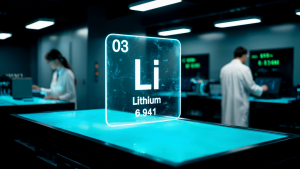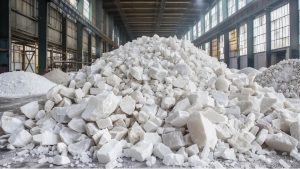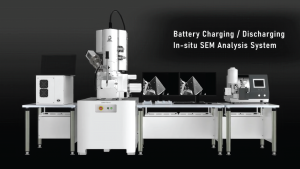This article is contributed by AmirReza Rouhani Esfahani
- Lithium-ion batteries (LiBs) power electric vehicles (EVs), with the anode playing a crucial role in their performance.
- Graphitic materials, chosen for their exceptional conductivity, thermal stability, and high performance, serve as the main anode materials in LiBs.
- Nevertheless, graphite anodes still suffer from initial capacity loss and limited first cycle efficiency.
- The leading solution has been to coat the graphite particles, that is, adding a protective layer to prevent unwanted chemical reactions during battery cycling and boost overall performance.
Introduction
Over the past three decades, lithium-ion batteries (LIBs) have undergone a remarkable evolution, transitioning from powering small devices to fueling large-scale applications like electric vehicles (EVs) and stationary energy storage systems. An important advancement in this journey has been the adoption of graphite-based anodes, replacing soft and hard carbons. This shift has significantly improved full-cell energy densities, thanks to graphite’s low lithiation/delithiation potential and impressive (theoretical) gravimetric capacity of 372 mAh/g [1].
The improvements in graphite electrodes, shown in Fig. 1, have a long history. Since 1975, we’ve known that graphite can form a chemical compound with lithium, namely LiC6, in a reversible process. In the 1970s, however, graphite could not be used successfully for batteries due to issues with the liquid organic electrolytes, which resulted in continuous decomposition. After two decades of research and development on graphite anodes, Sony achieved a major milestone with the first lithium-ion battery in 1991, a breakthrough in battery technology [2].
Since 1994, most commercial lithium-ion batteries have been manufactured with graphite as the active material for the negative electrode because of its low cost, relatively high (theoretical) gravimetric capacity of 372 mAh/g, and high coulombic efficiency. According to the 2015 anode materials market share, about 98% of anodes for LiBs are made with carbon-based materials. The remaining 2% are made with silicon (Si) and lithium titanium oxide (LTO). Large EV and cell manufacturers believe that graphite will continue to remain a vital component of LiBs either as the sole anode or in composites with other elements, such as Si [1,2].
What Is Graphite?
Carbon is the sixth element in the periodic table, with a molecular weight of 12.01 g/mol. Carbon materials in nature have two dominant structures: diamond and graphite. In graphite, sp2 hybridized graphene layers are connected via weak van der Waals forces. This bonding pattern results in a hexagonal arrangement of atoms, which are layered in sheets with an interlayer spacing of 3.354 Å, as presented in Figure 3(a). The relatively weak van der Waals forces between adjacent graphene layers facilitate intercalation — insertion into two-dimensional layered structures — of ionic and molecular species between the surfaces. The van der Waals forces allow the space between the layers to expand, eventually leading to a re-stacking of the graphene layers and enabling the reversible intercalation of lithium ions between them. The remarkable reversibility of this intercalation reaction, coupled with minimal volume changes, is responsible for graphite’s long-lasting efficiency and reliability in lithium-ion batteries and underscores graphite’s significance as an anode material [2].
Due to its layered arrangement, graphite particles typically exhibit a flat, flake-like shape with two distinct surfaces: basal planes of dimension La and edge planes of height Lc, also known as prismatic planes. This is depicted schematically in Fig. 3 and in an SEM (scanning electron microscopy) image in Fig. 4. Accordingly, the edge planes show a higher intercalation/deintercalation reactivity than the basal planes [3].
Edge planes in graphite are recognized as active sites, playing a pivotal role in various reactions. These edge sites, however, are a double-edged sword, instigating unwanted reactions that compromise the efficiency of the system. The electrochemical performance of graphite electrodes depends heavily on the ratio of basal to edge planes. While edge planes facilitate intercalation, an excess of edge planes may also lead to increased surface reactivity, including side reactions or degradation over prolonged use, which weaken the long-term stability and cycle life of the battery. Notably, different types of graphite may exhibit variations in their basal-to-edge plane ratios, influencing the overall efficiency and charge-discharge characteristics of the battery and their suitability for specific applications. This underscores the importance of tailoring graphite structures for optimized electrochemical performance in diverse battery systems [1,2].
The Solid Electrolyte Interface (SEI)
As discussed, irreversible capacity loss stems from the breakdown of electrolytic substances, leading to unwanted reactions and the formation of a Solid Electrolyte Interface (SEI) film on the surface of the graphite. Commonly used electrolytes in lithium-ion batteries (LiBs), like propylene carbonate (PC) and ethylene carbonate (EC), react strongly with graphite, creating the SEI film. While crucial for stabilizing the electrode-electrolyte interface, the SEI film also reduces overall battery capacity due to the irreversible loss of Li ions on the graphite surface in the process of forming SEI.
Unfortunately, the SEI does not form only on pristine graphite in the first cycle; it continues to evolve during usage of the battery, spurred by ongoing interactions with the electrolyte. The cycling process induces a minor volumetric expansion in graphite through intercalation/deintercalation, resulting in microcracks in the SEI. These microcracks open the door for further SEI formation on the newly exposed surfaces, leading to an accumulation of capacity loss over time. Among various methods, coating has emerged as the most effective approach to reduce the formation of microcracks in order to address the initial capacity loss in graphitic anodes [1,2].
Graphite Coatings
The properties of the Solid Electrolyte Interface (SEI) depend largely on the electrolyte composition and graphite surface characteristics. Surface modification methods, such as coating, can be used to promote the early formation of a stable SEI. This stable interface prevents unwanted reactions and is essential for enhancing cyclability and initial coulombic efficiency (ICE). Using surface modification to improve performance was first demonstrated in 1996, when Peled et al. [4] showed a 10% improvement in initial coulombic efficiency through the mild oxidation of graphite particles at 550 °C for 1 hour. Various precursors, including metals, gases, and solid carbons, have been employed to modify the surface of LiB graphite. So far, the most investigated and most cost-effective surface coating material is carbon — and not only for graphite but for cathode as well as anode materials. In this process, the graphite is initially coated with a carbon saturated precursor such as glucose. To stabilize the coating, a heat treatment at high temperature (e.g., 900 °C) is required to carbonize (converting organic material into carbon) the precursor-coated sample. By covering the reactive sites of the graphite nanostructure, carbon mitigates negative reactions between the SEI and the electrolyte. Because these carbonaceous coatings have lower density and significantly lower energy storage capacity compared to graphite, however, they can lead to lower gravimetric and volumetric energy densities at the full-cell level.
Among carbon-based agents, coal-tar pitch (CTP) is the standard industrial coating material that provides a homogeneous amorphous carbon coating on the graphite surface while enhancing the capacity, rate capability, and initial coulombic efficiency of the graphite anode. Based on the work of Han et al. [5], CTP-coated graphite provides an initial coulombic efficiency of 90.3% as well as high-rate capability. Despite its good electrochemical features, the use of CTP has negative health and environmental implications. CTP is produced by distilling coal tar, a byproduct of carbonizing coal to make coke or gas, a process that is carbon-intensive and can release polycyclic aromatic hydrocarbons (PAHs) into the environment. In addition, the National Cancer Institute has found that exposure to CTP increases the risk of skin cancer and is linked to other types of cancer, including lung, bladder, kidney, and digestive tract cancer [6].
Future Work
Researchers are currently dedicated to developing the most environmentally friendly advanced graphite anode coating material for lithium-ion batteries (LiBs). They are looking to use a biomass-derived carbon coating to create an electrochemically efficient anode that matches or surpasses the performance of CTP-coated graphite while minimizing health and environmental impacts. Despite the challenges associated with biomass-based coating agents, including higher inorganic impurity content and variable properties, the pursuit of sustainability remains a driving force in the quest for improved battery materials. While CTP offers consistency, it is not renewable, highlighting the importance of exploring alternatives with lower environmental footprints [2].
Conclusion
Graphite’s unique layered structure makes the material well-suited for lithium-ion intercalation. Starting from 1994, almost all commercial LIBs were (and still are) based on graphite as the active material for the negative electrode. Despite possessing excellent conductivity and stability, graphite anodes experience high first cycle capacity loss due to undesired electrolyte decomposition reactions and the uncontrolled formation of the solid electrolyte interface (SEI).
Coating of the graphite surface has been one of the most effective methods to address this issue. Balancing cost and complexity while improving the stability, efficiency, and capacity of the battery is key for advancing graphite-based anodes in batteries. Among the materials tested, disordered carbon coatings have shown the best results for preventing unwanted reactions on the graphite anode and reducing the first-cycle capacity loss.
Coal-tar pitch (CTP) is the standard industrial coating for graphitic anodes but has significant environmental and health concerns. Current research aims to develop greener alternatives, such as biomass-derived carbon coatings, to achieve an electrochemically efficient anode with reduced adverse effects.
AmirReza Rouhani Esfahani (Amir Rouhani for short) is a Ph.D. candidate in the Department of Materials Engineering at McGill University in Montreal, Canada. With a background in materials synthesis and particle chemistry, Amir’s earlier research focused on magnetic and plasmonic nanoparticles during his undergraduate and master’s studies. His current research looks at surface modification of battery materials, aiming to design environmentally friendly electrode materials for the next generation of lithium-ion batteries (LIBs).
References
[1] Warner, J.T., 2019. Lithium-ion battery chemistries: a primer. Elsevier.
[2] Asenbauer, J., Eisenmann, T., Kuenzel, M., Kazzazi, A., Chen, Z. and Bresser, D., 2020. The success story of graphite as a lithium-ion anode material–fundamentals, remaining challenges, and recent developments including silicon (oxide) composites. Sustainable Energy & Fuels, 4(11), pp.5387–5416.
[3] Ouzilleau, P., Gheribi, A.E. and Chartrand, P., 2016. The graphitization temperature threshold analyzed through a second-order structural transformation. Carbon, 109, pp.896–908.
[4] Peled, E., Menachem, C., Bar‐Tow, D. and Melman, A., 1996. Improved graphite anode for lithium‐ion batteries chemically: Bonded solid electrolyte interface and nanochannel formation. Journal of The Electrochemical Society, 143(1), p.L4.
[5] Han, Y.J., Kim, J., Yeo, J.S., An, J.C., Hong, I.P., Nakabayashi, K., Miyawaki, J., Jung, J.D. and Yoon, S.H., 2015. Coating of graphite anode with coal tar pitch as an effective precursor for enhancing the rate performance in Li-ion batteries: Effects of composition and softening points of coal tar pitch. Carbon, 94, pp.432–438.
[6] Jang, T.W., Kim, Y., Won, J.U., Lee, J.S. and Song, J., 2018. The standards for recognition of occupational cancers related with polycyclic aromatic hydrocarbons (PAHs) in Korea. Annals of Occupational and Environmental Medicine, 30, pp.1–6.




